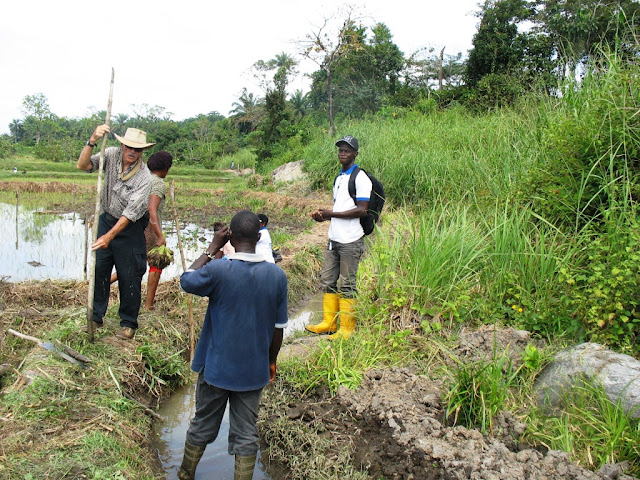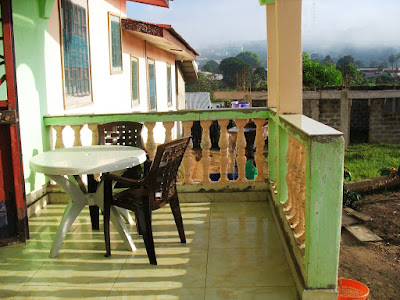Smallholder Oil Palm Project Support II (SHOPS II)
Oil Palm Processing
Current problem is proccessinng of the native oil palm variety Dura
Amos W. Dolo Stands at his kernel processing business.
Amos is an Oil Palm processor, farmer and school principle for Ganta, Nimba County.
Oil Palm kernels are separated from shell in a water bath. Shells sink, oil rich kernels float.
Step seven in process when Kernel Press used. (See last frame of a Kernel Press)


 Oil Processor foreground. Buyer in back waits w/20 lt. jug value $15 value.
Oil Processor foreground. Buyer in back waits w/20 lt. jug value $15 value.
LPMC Plantation Gabanga, Bong County: Supports 100 HA plantation. Farmer supplies equipment and land for 1/3 oil, tenants supply labor.
Step _5_ in process .
Market Display of jars and packages cooking oil. Going to the market is a daily event. Palm oilis used in all local cooking. The oil palm native to West Africa, but now after ten years of cilivil war only one-half of the oil used in Liberia is produced locally.
Palm Oil is extracted from the outer layer tin pericarp (flesh). Oil is collected in 20 liter jugs.
Oil Palm fruit is prepared in a one barrel operation for oil extraction at the Amos Dolo 26 HA farm
T
he Oil Palm fruit is heated three hours.
LPMC Farm - Step one.
Operation is tended by crew of six. This includes, feeding fruit into funnel, manual power, waste removal below extraction chamber and oil collection from pan.
LPMC Farm - Steps three, four and five.
The Oil Palm fruit loaded into Freedom Mill II.
Oil is pressed from the tin pericap - Step two.
|
Incomplete oil extrusion of the Dura fruit is the critical stage of manual operation which requires the modification. It is believed the thicker and tougher pericarps of the native Dura. The larger kernels are the cause of the three chamber press to only partially squeeze the oil out. A fourth chamber will be used in a new model.
This Oil palm Fruit is from a 37 year old Tenera tree which
has reverted to a Dura size Kernel. The tin pericarps are 5 mm thick the fruit
is 2.5 by 3.5 cm. Wild Dura has larger kernels and thinner flesh. A second
loading is needed to break the skinks and extract the oil.
Improvements are being made to the extruder chamber to extract the oil from the larger kernels.
Pit for old style Oil processing. Fruit is placed in the burn pit to heat. Then when hot wooden stick mallets were used to mash to apart. Oil floated to top and was dipped with a ladle.
Production may have been 1 to 10 liters per day. The Manual Freedom Mill II can produce 240 liters in a day when serviced by six people
The old oil Palm groves many as this one over 30 years old need of replacement with new trees.

The Dura variety fruit is now more prevalent in the old groves and also is found in the wild in Nimba and Bong Counties. This has made the need for better oil processors now.
The Kernnel processor is a value added machine
In addition to extraction of the higher value oil of the kenneral the by-product meal is cattle feed.


























































